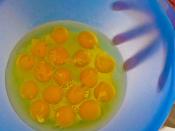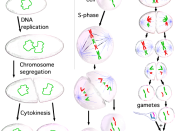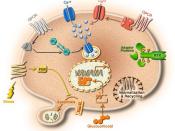The cell is the basic functioning unit of organisms in which chemical reactions take place. These reactions involve an energy release needed to support life and build structures. The cell consists of membrane bound organelles, which are responsible for the division of labour. There are two main classes of cells- Prokaryotes which are cells without a nucleus, where the DNA is spread around the cytoplasm of the cell, an example of a prokaryote is a bacterium (See Figure 1). The other class is the Eukaryotes which are the cells of plants and animals, and example is a palisade cell (See Figure 2). Both have similarities and differences in their functions and structures.
Both Prokaryote and Eukaryote cells consist of Cell wall, (however this is not present in animal cells) - this is made of Peptidoglycan (though the plant cell is made of cellulose microfibrils embedded in a layer of calcium pectate and hemicelluloses).
The cell wall provides support for a plant cell, and controls what goes in and out, allowing the cell to build a hydrostatic skeleton, giving the cell shape and rigidity. The Cells also contain a cell membrane made of phospholipids and proteins, designed to control what goes in and out of the cell. DNA is also found in both cells, which carries the genetic information for the cell, allowing for replication. Like DNA, ribosomes are also found in both cells. The ribosome is made of rRNA and they synthesise protein, as they are the site where mRNA meets tRNA so that amino acids are bonded together. However, the size of the ribosome differs- in a prokaryote the ribosome is around 70 Svedberg's, while in a Eukaryote it's larger at around 80 Svedberg's. Both cells have similar metabolisms and are amazingly diverse in their forms- for...


